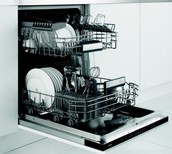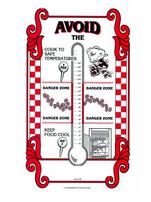Basic Kitchen Safety

We have to include this, really. I'll try to keep it entertaining. Please also see our disclaimer.
It really does make a difference, you know. And you probably already do a lot of these things from simple common sense. But here are a few tips for basic kitchen and food handling safety.
1. Wash.
Wash your hands.
Wash before you even start getting out your ingredients and equipment.
Wash the vegetables and the fruit.
Wash when switching from one raw ingredient to another, especially something messy.
Wash after you're done.
Wash the utensils and bowls.
Wash the cutting boards.
Wash the counter.
Wash the table.
Just wash. If there's only one thing you do, do this.
And please use soap. Please don't just use a wet rag or a disinfectant wipe. Hot water and soap.
It really does make a difference, you know. And you probably already do a lot of these things from simple common sense. But here are a few tips for basic kitchen and food handling safety.
1. Wash.
Wash your hands.
Wash before you even start getting out your ingredients and equipment.
Wash the vegetables and the fruit.
Wash when switching from one raw ingredient to another, especially something messy.
Wash after you're done.
Wash the utensils and bowls.
Wash the cutting boards.
Wash the counter.
Wash the table.
Just wash. If there's only one thing you do, do this.
And please use soap. Please don't just use a wet rag or a disinfectant wipe. Hot water and soap.
2. Use different knives and cutting surfaces in preparation of raw meat and produce.

Icky germ-bugs from raw meat (and its associated blood and other ewy stuff) gets down in the cracks of even the best cutting boards. So don't cut your carrots for the salad on the same cutting board you just rinsed off after chopping up a chicken.
Really, the best way to do it is to have dedicated cutting boards for meat and non-meat. Maybe even in different colors. You could get really persnickety and get several. One source suggests:
Really, the best way to do it is to have dedicated cutting boards for meat and non-meat. Maybe even in different colors. You could get really persnickety and get several. One source suggests:
- Green: Fruits & Vegetables
- Yellow: Raw Poultry
- Blue: Cooked Food
- White: Dairy Products
- Tan: Fish & Seafood
- Red: Raw Meat
3. Sterilize your equipment, especially that used to process raw meat.

My mother insists that her wooden spoons and cutting boards last longer when washed by hand. Personally, I stick everything in the dishwasher (when one's available) because there is no way I can get the water in the sink hot enough to sterilize it.
An alternative, if you're like Mom, is to nuke them. Just stick your wooden stuff in the microwave on high for 30 seconds or so (not sure about the time) - and make sure there isn't any metal in it!
Another alternative is to sanitize by spraying vinegar or hydrogen peroxide on the wood.
Or stick it in a pot and boil it. Whatever works for you. You can find lots of info online.
An alternative, if you're like Mom, is to nuke them. Just stick your wooden stuff in the microwave on high for 30 seconds or so (not sure about the time) - and make sure there isn't any metal in it!
Another alternative is to sanitize by spraying vinegar or hydrogen peroxide on the wood.
Or stick it in a pot and boil it. Whatever works for you. You can find lots of info online.
4. Follow recipe instructions, including those on pre-packaged stuff.

If it says to let it boil for X amount of time, it may be as much about killing bacteria as about getting the thing soft.
This is a good tip for the quality of the finished product, too. Altering recipes should be done carefully.
This is a good tip for the quality of the finished product, too. Altering recipes should be done carefully.
5. Take advantage of your refrigerator and freezer.

Don't leave stuff out overly long - while food doesn't usually lead to instant death if left on the counter by accident all afternoon or even over night, its life span will be shortened. And some things may indeed make you sick if they're too warm for too long, especially in warmer months.
6. Do your research.

Don't take what marketing campaigns tell you at face value. A lot of "food safety tips" are simply marketing techniques to get you to throw out perfectly good food and buy more. Like expiration dates on canned foods. Eating something the day after the date on the package in all likelihood will not kill you. Usually that's just when the quality begins to degrade.
Just put on your silly hat, people.
Just put on your silly hat, people.
7. If it smells funky, don't eat it. If it has weird looking stuff on it, cut it off.

If there's a LOT of weird looking stuff on it, feed it to the dog, or the hog, or the chickens. Our chickens are well fed.
If you want to know the truth, a lot of that funky smelly and weirdly fuzzy food won't actually kill you. It won't even make you sick if you know what to do with it. But we've become so enculturated to believe that if it looks or smells "odd" it will kill you that we miss out on a lot of really great stuff! (Can you say marketing? Food companies want you to buy more so they tell you something will kill you that won't. Go back and review #6.)
If you want to know the truth, a lot of that funky smelly and weirdly fuzzy food won't actually kill you. It won't even make you sick if you know what to do with it. But we've become so enculturated to believe that if it looks or smells "odd" it will kill you that we miss out on a lot of really great stuff! (Can you say marketing? Food companies want you to buy more so they tell you something will kill you that won't. Go back and review #6.)
8. Finally, don't visit our kitchen as a model of food preparation safety. We're farmers - we have stuff sitting around all the time! But not what we sell you! That goes in the fridge right away (except eggs) ... which is one reason ours gets left out.
A Word on Egg Freshness
The USDA says one thing, the Egg Safety people say something else, and everyone is confused - when are eggs safe to eat and when aren't they? Here are a few links to assist you in making your own decision.
Everything the USDA has to say on the subject of eggs
The Egg Safety Center
How to Tell if an Egg is Bad
More on eggs here.
The USDA says one thing, the Egg Safety people say something else, and everyone is confused - when are eggs safe to eat and when aren't they? Here are a few links to assist you in making your own decision.
Everything the USDA has to say on the subject of eggs
The Egg Safety Center
How to Tell if an Egg is Bad
More on eggs here.